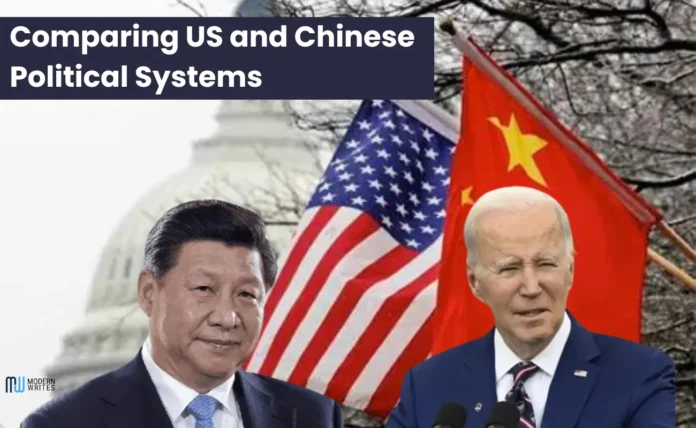The political systems in the United States and China are a unique graph of two different models. That reflect various historical trajectories, ideological bases, and governance structures. These dissimilarities serve to wedge out the political structures of both countries. US and Chinese Political Systems
A learned estimate of every nation’s political landscape is mandatory to have a complete understanding of the type of dynamics that each system provides to domestic governing and foreign relations. Hence, the information on the differences between the USA and China political systems presented in this class is important to our understanding of political systems. US and Chinese Political Systems
Historical Context and Ideological Foundations
Since the ideals of democracy, equality, and constitutionalism are what the Declaration of Independence and the Constitution stand for. Therefore the political legacy of the USA goes back to the doctrines and principles of these two documents. In the Age of Enlightenment, the American political system drew its foundation from principles such as personality rights, representative democracy, and the separation of powers among the executive, legislative, and judicial branches. US and Chinese Political Systems
While centuries of imperial rule, intricate bureaucracy, turbulent times of revolutionary upheavals. And the rise of the Chinese Communist Party (CCP) under Mao Zedong shaped the political system in China. US and Chinese Political Systems
The political system in the United States has heavily referenced the ideals of republicanism, federalism, and representative democracy. The core ideas of the Chinese Communist ideology, which is the communist system of Marxian Leninism. And are class struggle, the rule of the proletariat, and a focus on state-led development. The CCP, the Chinese communist party, is still the ruler in the Chinese political area. And making itself a symbol of the Chinese people. Although it has witnessed economic reform in the late 1970s. US and Chinese Political Systems
Governance structures and decision-making processes
The US and China built up legislation and decision-making mechanisms. But these institutions possess different characteristics that are very important and essential in their political systems. In the United States, the federal government, state governments, and local governments all exercise their statutory powers and responsibilities in different spheres. Which allows devolution of powers from the central government.
The government maintains the system of separation of powers to control the executive, legislature, and judiciary departments. This system ensures the prevention of power instigation and the protection of individual rights. The Communist Party of China (CCP), which controls the highest power in all spheres, including national, provincial, and local, is at the center of China’s hierarchical and centralized political structure.
The totalitarian party is the one and only hegemonic entity that has the final authority in public matters, including the judicial industry, the military, and the press. The Chinese Communist Party (CCP) distinguishes itself with a centralized and opaque leadership style that dominates the decision-making process. The CCP’s elite party managers are the state’s policymakers, who then implement these policy initiatives through convoluted bureaucratic institutions. US and Chinese Political Systems
US and Chinese Political participation and civil liberties
Furthermore, the differences in political systems, political participation, and civil liberties between the United States and China could lead to significant consequences. In the United States of America, inhabitants have the opportunity to take part in different forms of political rights, which include voting, speaking, assembly, and association.
Federal, regional, and municipal elections with concurrent opportunities for citizen engagement and accountability are also bound to face party chairmanship and finance limitations. There are a variety of competitions at all levels. While political involvement in China is limited, the Communist Party of China (CPC), which holds the supreme power and governs public life at a high level of dominance, explains why.
The Chinese Constitution theoretically provides the freedom of expression, the freedom of gathering, and the freedom of religion. However, in practice, censorship, monitoring, or the suppression of dissidents often endanger these rights. If we added an independent court and media, we would eliminate the most important chance for recourse and accountability, which fuels the Party’s centuries-long authoritarian grip on power.
US and Chinese Political Systems & Economic Policies
However, the economic paths and level of development aimed at by the USA and China, which are two political systems based on very opposite views, also directly influence these policies and goals. Capitalistic principles, free enterprise, and a limited government role in the economy are the most admittedly American things.
Despite this argument about the difference between the US and Chinese political systems and the main principles of competition, innovation, and entrepreneurship as drivers of economic dynamism and growth, the underlying issues related to income inequality, regulation, and social welfare are equally relevant.
China, on the other hand, has been implementing a Chinese economic model that integrates socialist planning, market reforms, and even elements of state capitalism. China has been running a policy of government-dominated development at a pace of industry turning, construction, and export boosting. These are the ways General Secretary Xi Jinping and the CCP have been directing them. US and Chinese Political Systems
Although this strategy has indeed boosted China up to the status of the second-largest economy in the world. But the issues of the state government, inefficiency, and the consequences of distorting the resource allocation system still exist.
Conclusion US and Chinese Political Systems
The political systems of the United States and China, each with two distinct structures, exhibit significant differences from one another. These variations are numerous examples of different historical stays, mindset preferences, and government systems. The Communist Party of China controls the country in accordance with its ideology and maintains party supremacy, limiting individual power and decentralizing governance.
However, the United States of America considers individual liberty and nuclear democracy principles to be its core values. Understanding the complexity of each state’s political environment and the impact of these differences is crucial. Internal affairs and international relations are key elements in grasping these ugly facts. US and Chinese Political Systems
In the great game of global politics, each of the two main players—the US and China—seeks to define the actionable scope of international relations and blaze the path to the future. Their interactions, not by chance, will be a key piece in the 21st century challenge. US and Chinese Political Systems





